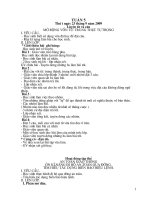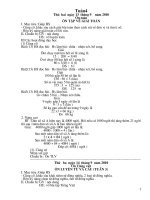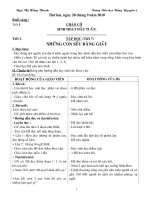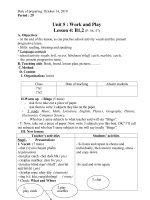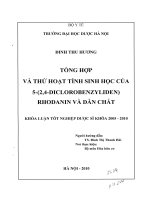5 2 4 habitats in need of help
Bạn đang xem bản rút gọn của tài liệu. Xem và tải ngay bản đầy đủ của tài liệu tại đây (5.6 MB, 14 trang )
Suggested levels for Guided Reading, DRA,™
Lexile,® and Reading Recovery™ are provided
in the Pearson Scott Foresman Leveling Guide.
Life Science
Habitats
in Need of Help
Genre
Expository
nonfiction
Comprehension
Skills and Strategy
• Fact and Opinion
• Author’s Purpose
• Ask Questions
Text Features
• Captions
• Labels
• Glossary
Scott Foresman Reading Street 5.2.4
ISBN 0-328-13527-5
ì<(sk$m)=bdfchb< +^-Ä-U-Ä-U
by Jane St. John
Reader Response
1. You have read about habitat loss. Much of what you
have read is fact, having been proven by scientists.
But some of what you have read is opinion. On a chart
similar to the one below, list three statements of fact
and three statements of opinion about how habitats
have been destroyed.
Habitats
in Need of Help
Statements of Fact
Statements of Opinion
2. In this book, the author talks about land, water, and
air pollution and habitat loss. Can you think of other,
more specific habitats? What kinds of pollution is
harming those habitats? How do you think you could
help save them?
3. Use the words from the glossary to write a short
newspaper article that urges readers to protect a
habitat in your neighborhood.
4. In three to five sentences describe what is happening
in the photograph on page 11 and how it relates to
habitat loss. by Jane St. John
Editorial Offices: Glenview, Illinois • Parsippany, New Jersey • New York, New York
Sales Offices: Needham, Massachusetts • Duluth, Georgia • Glenview, Illinois
Coppell, Texas • Ontario, California • Mesa, Arizona
Habitats as Homes
What is a habitat? It is an environment in which a
living thing, such as an animal, grows and thrives. Every
animal has special requirements of its environment. An
animal’s habitat must contain enough food, water, shelter,
and nesting places for it to survive. A habitat is its home.
Habitats are found all over the world. Your own backyard
is a habitat. Oceans, rivers, and freshwater lakes are water
habitats. Forests, deserts, and prairies are land habitats.
Habitats are all around us, and some of them are at risk.
Every effort has been made to secure permission and provide appropriate credit for
photographic material. The publisher deeply regrets any omission and pledges to
correct errors called to its attention in subsequent editions.
Unless otherwise acknowledged, all photographs are the property of Scott Foresman,
a division of Pearson Education.
Photo locators denoted as follows: Top (T), Center (C), Bottom (B), Left (L), Right (R),
Background (Bkgd)
Opener: Getty Images; 1 ©DK Images; 3 Digital Vision; 4 Getty Images; 5 Getty Images;
6 W. Wayne Lockwood, M.D./Corbis; 7 © Comstock Inc.; 8 Brand X Pictures; 9 Brand
X Pictures; 10 Getty Images; 11 ©DK Images; 12 ©Image Source Limited; 13 ©DK
Images; 14 Getty Images; 15 Getty Images; 16 Digital Vision; 17 ©DK Images; 19 Fred
Bruemmer/Peter Arnold, Inc.; 21 ©DK Images; 22 Getty Images; 23 Digital Vision
ISBN: 0-328-13527-5
Copyright © Pearson Education, Inc.
All Rights Reserved. Printed in the United States of America. This publication is
protected by Copyright, and permission should be obtained from the publisher
prior to any prohibited reproduction, storage in a retrieval system, or transmission
in any form by any means, electronic, mechanical, photocopying, recording, or
likewise. For information regarding permission(s), write to: Permissions Department,
Scott Foresman, 1900 East Lake Avenue, Glenview, Illinois 60025.
2 3 4 5 6 7 8 9 10 V0G1 14 13 12 11 10 09 08 07 06 05
3
Land at Risk
Natural disasters can destroy peoples’ homes and
animals’ habitats.
What would you do if your home was destroyed?
Families who survive natural disasters, such as
tornadoes and hurricanes, sometimes face this
question. Fortunately, it is only rarely that people
lose their homes due to natural disasters. For animals,
however, habitat loss occurs much more often. Nature
sometimes destroys animals’ habitats. A beaver’s dam
can be ruined in a rainstorm, and a sudden snowstorm
can wreck a bird’s nest.
Scientists called ecologists have found that
increasing human populations and their daily activities
directly contribute to the loss of many animal habitats.
Today, about 50 percent of the world’s land surface is
considered destroyed or disturbed. By 2032 that level
may reach 70 percent. Destruction of animal habitats
threatens to ruin entire ecosystems, or environments,
and the animals that live in them. We must discover
and learn about new ways to protect these ecosystems.
4
The black bear is one animal whose habitat has
been deeply impacted by humans. Black bears like
to live in old forests filled with hardwood trees. In
spring and summer they feed on the forest’s berries
and leaves. In the fall they remain deep in the woods,
where the plant growth is thick, as they prepare to
hibernate for the winter.
Black bears are shy by nature and avoid humans.
Many of their habitats, however, have been destroyed
due to the construction of houses and roads. In many
regions, bears have had to learn to become more
comfortable around humans in order to survive.
Near Lake Tahoe, California, black bears discovered
that they could feed and rest comfortably in an
environment controlled by humans. Now, the black
bears of Lake Tahoe
feed on scraps of
food from garbage
cans and campsites
and sleep under
people’s porches.
Black bears’ lives have
changed dramatically
in places where
humans have altered
their habitats.
5
The black bears of Yosemite National Park have
learned that it is easier to find scraps of food in the
cars and trash of the park’s visitors than it is to wander
around looking for berries.
Park officials have developed regulations to help
visitors avoid contact with bears. These regulations
warn visitors to hide their food. Without these
regulations, bears would continue to depend on
humans for food instead of relying on their natural
environment. Sometimes, a black bear becomes so
dependent on humans that park officials are forced to
move the bear to another part of the park.
Some black bears are too dependent on humans for food.
6
Habitat destruction
has caused orangutan
populations to
decline.
Another forest-dwelling animal whose habitat
is at risk is the orangutan. Its homes are the island
of Borneo and the neighboring Indonesian island of
Sumatra. This huge ape (ranging from sixty to three
hundred pounds) needs large areas of forest in which
to roam. Unfortunately, humans have taken over land
for mining, logging, and various types of farming, so
less than 20 percent of the orangutan’s original habitat
remains.
When a habitat is destroyed, the animal’s food
supply decreases, and it can no longer thrive. During
the past one hundred years, orangutan populations
have decreased by about 90 percent. Some researchers
estimate that there are fewer than thirty thousand
orangutans on the islands today.
Many organizations are concerned about the
survival of orangutans. Orangutan Foundation
International is one group working to protect the
tropical forests that orangutans call home.
7
Like orangutans, Asian elephants are threatened
by habitat loss. Asian elephants live on forest-covered
lands. But those lands are also used by 1.5 billion
people, leading to an uneasy mix. In India, Thailand,
and Sumatra, the clearing of forests—in many cases
to make space for growing human populations—has
placed Asian elephants in serious trouble.
Forest clearing has resulted in a loss of Asian
elephants’ natural habitat. This loss is especially
troubling for Asian elephants because they are
migratory. Now, when Asian elephants migrate, they
become trapped in small forest pockets.
Just as groups are working to save the habitats of
orangutans, others are working to protect forests that
elephants call home.
Like their Asian cousins, African elephants are
threatened by habitat loss.
8
9
Monach butterflies are as small as Asian elephants
are large. But as with Asian elephants, human activities
have severely affected their migration patterns.
Migrating monarch butterflies fly from North America
to Mexico for the winter. There they rest before
returning north for the summer. Part of Mexico’s
evergreen forest is a protective shelter for the butterfly.
In spite of this, the forested region is losing trees at
an alarming rate. Once the tourists and butterflies have
left for the season, loggers come to clear the land. In
Mexico there is an increasing demand for wood and
the crops that can be planted on cleared land.
Growth in
farming has hurt
natural habitats.
Habitat loss in Mexican forests has
caused major problems for the monarch
butterfly.
10
Unfortunately, Mexico is not the only country
where the clearing of land for crops has hurt habitats.
There are many examples of habitats that have been
damaged or destroyed to make room for farmland. In
the United States alone, more than 90 percent of our
native prairies have been lost to farms.
Changing habits and demands of humans can
forever change an ecosystem. For example, worldwide
demand for rice, wheat, and corn is expected to grow
40 percent by 2020. This means that the demand for
irrigation—changing the paths of waterways to get
water to crops—is expected to rise 50 percent or more.
In all likelihood this will lead to increased pressure to
transform many areas into agricultural regions.
11
Water Habitats in Danger
Land habitats are not the only ones in danger.
Marine habitats, and the animals that live in them, are
threatened as well. There are about fifty “dead zones”
along the world’s coasts, for example. These are areas
in which those coastlines’ ocean creatures simply can
no longer live. The largest dead zone in the Western
Hemisphere is along the Gulf of Mexico. There, excess
phosphorus and nitrogen from the Mississippi River
flowed into the Gulf and damaged the ecosystem.
A specific example of the harm caused by dead
zones involves the Mexican gray whale. In 1999,
dozens of gray whales were reported killed off the
coast of Mexico. It was suspected that they had died
from excess salt in the water. The salt had come from
salt-making operations near the coast.
Mexican gray whale
Scientists have identified approximately fifty
“dead zones” along the world’s coasts, where
ocean creatures can no longer live.
12
13
Of all the whale species that swim the coast of
the United States, the humpback whale is probably
the most famous. Its fame comes from the dazzling
leaps and displays that it makes. Today, there are
perhaps ten thousand humpbacks worldwide. This is
estimated to be 8 percent of the original humpback
whale population. In the mid-1800s, about 125,000
humpback whales lived worldwide. Like other whales,
they were hunted for their meat, oil, and a substance
called baleen attached to their jaws. At that time,
whale oil was used in street lamps, and baleen was
used to make women’s dresses.
In 1966 the International Whaling Commission
gave all humpbacks protected status, by prohibiting
people from hunting them. However, some
countries have ignored the ban and continue to
hunt. Humpbacks have also been hurt by becoming
entangled in fishing gear and ocean debris. Ship
collisions have resulted in humpback whales being
stranded, and jet skis and parasails near Hawaii have
been hazardous to humpbacks and their ecosystem.
14
The overeating of sea otters by orcas led to the reduction
of kelp forests in Alaskan coastal waters.
The hunting of whales can have a domino effect on
other species as well, as an investigation into changes
in Alaska’s coastal ecosystems revealed. Off the coast of
Alaska, from the 1940s through the 1970s, overfishing
of many of the species of large whales, such as fins and
humpbacks, caused orcas to seek prey other than the
large whales that they normally ate. Orcas began to
prey on harbor seals, then fur seals, then sea lions, and,
at last, sea otters for food. The sea otter population was
reduced to such a low level that there were not enough
of them to feed on all the sea urchins. This caused
the sea urchin population to grow by a huge amount.
Sea urchins overgrazed, which led to the reduction of
Alaska’s kelp forests in its coastal waters.
15
Coral reefs are one kind of ocean habitat. Like kelp
forests, they have experienced trouble. In fact, coral
reefs are considered endangered. A reef is a fragile
limestone framework in which corals and other types
of animals, such as jellyfish, sea urchins, and sponges,
live. It is believed that up to 25 percent of the world’s
coral reefs have already been destroyed. Overfishing,
marine pollution, and an increase in viral and bacterial
diseases that can kill coral are to blame.
Tropical storms, such as cyclones and hurricanes,
make reefs weaker and more prone to habitat
destruction. Reefs have also been affected by human
activities. Australia’s Great Barrier Reef is one such
reef. Its population of nesting loggerhead turtles has
decreased greatly since the 1960s. It is believed that
this can be directly traced to increased farming and
material deposited in the ocean through runoff.
Many other species of marine life in the world’s
oceans are also in trouble. For example, it is estimated
that since the 1950s tuna and marlin populations have
been reduced by 90 percent, due to overfishing and
harmful fishing methods.
Overfishing has been so harmful that, even when
fishing has been reduced, it has taken several years
for the fish to “catch up.” For example, Canada and
New England’s cod populations dropped so low in the
1990s that only 1 percent of their original population
remained. The Canadian government closed cod
fishing areas for several years to allow the species to
recover. Still, the cod population remains very low.
Red snapper, which lives off the west coast of the
United States, is another fish that is now in danger.
Overfishing is to blame, along with the fact that shrimp
trawlers often capture 10 to 20 million very young red
snappers every year.
Fishing trawler
16
17
The polar bear is the
largest of the eight bear
species on Earth. It lives
along the Arctic Circle, in
North America, Russia, and
Norway. The polar bear is
considered the world’s largest
land predator. It is the only
bear that eats mostly meat.
But today polar bears are
under pressure. The gradual
warming of their habitat has
caused ice packs to break up
across the Arctic.
The melting of the polar
ice caps means the bears are
often stranded onshore and
have less time to fatten up
each summer. As a result,
some female bears cannot
produce enough milk for
their cubs, and fewer cubs
are able to survive the harsh
winters. Polar bears are also
threatened by oil spills. Oil
partially strips the polar bear’s
fur of its warming properties
and covers the bear’s prey as
well. Toxic chemicals and air
pollution also threaten the
Arctic region.
18
19
Air Troubles
The air quality of an environment can affect
habitats too. In parts of Inner Mongolia, mining
activities and accidents have sparked numerous fires in
underground coal mines. The fires have put harmful
chemicals into the air. These chemicals have polluted
the groundwater that animals drink and produced acid
rain that destroys the plants that some animals eat.
Although Inner Mongolia probably has the worst
problem with coal fires, they have also occured in
India, Indonesia, and even the United States. In 1962
an abandoned mine in Centralia, Pennsylvania, was
used to burn trash. The fire from the burning trash
grew out of control. As a result, the fire is still burning,
and has caused devastation and destruction of many
habitats.
Wind turbines, in contrast to coal, are a source of
clean, renewable energy. Unlike power plants, they do
not pollute while generating electricity. Unfortunately,
despite these benefits, the wind turbines on modern
wind farms have killed many birds. Near San Francisco,
California, it is estimated that 22,000 birds have
been killed by the blades on wind turbines. The
wind turbines have only been around for a couple of
decades. Because of that, California’s birds have not yet
learned to change their flight paths, thereby avoiding
the turbines. One suggestion that people have made
to help birds adjust is to paint the blades of the wind
turbines in colors and patterns that birds can see more
easily. This might encourage the birds to fly farther
away from the machines.
Wind turbines such as these are a great source for clean
energy, but they have led to the deaths of many birds.
20
21
Factories and power plants are a major cause for habitat
loss and destruction.
Helping Habitats
You have just read about many habitats and
ecosystems that are in danger. Habitats can be spoiled
in two main ways. Either the amount of habitat
is reduced, such as when a wetland is paved for a
highway, or the quality of the habitat is changed. A
company that dumps toxic wastes into a waterway is
reducing the quality of that ecosystem.
In 1995 the United States Geological Survey
documented the extent to which habitats in our
country were in danger. Altogether it listed 126
ecosystems as being either critically endangered,
endangered, or threatened.
Technological improvements, while mostly positive,
also have the unfortunate side effect of causing large-scale
damage to happen more quickly than it did in the past.
But what can we do to halt and repair this damage?
22
Fortunately, there are many successful examples
of states, organizations, and individuals working to
preserve habitats. For example, the states of Delaware
and Virginia have programs that encourage citizens to
understand ecological resources. West Virginia allows
its residents to adopt birds at its Raptor Rehabilitation
Center. South Dakota is a leader in preserving prairie
lands. A conservation program there has encouraged
ranchers to return farmland to native grassland while
still allowing cows and other animals to graze.
You, too, can help in many ways. Visit your local
library or historical society to see some before-and-after
photographs of development in your area to understand
how the habitat around you has changed. Be an
enthusiastic supporter of efforts to save local
habitats and the animals that live in them. Talk to your
family. Put your habitat-saving ideas into action!
23
Glossary
Reader Response
conservation n.
preservation from harm or
decay.
1. You have read about habitat loss. Much of what you
have read is fact, having been proven by scientists.
But some of what you have read is opinion. On a chart
similar to the one below, list three statements of fact
and three statements of opinion about how habitats
have been destroyed.
contribute v. to help bring
about.
enthusiastic adj. full
of enthusiasm; eagerly
interested.
environment n. the
circumstances or
conditions of air, water,
and soil.
investigation n. a careful
search.
Statements of Fact
Statements of Opinion
2. In this book, the author talks about land, water, and
air pollution and habitat loss. Can you think of other,
more specific habitats? What kinds of pollution is
harming those habitats? How do you think you could
help save them?
3. Use the words from the glossary to write a short
newspaper article that urges readers to protect a
habitat in your neighborhood.
4. In three to five sentences describe what is happening
in the photograph on page 11 and how it relates to
habitat loss.
24
